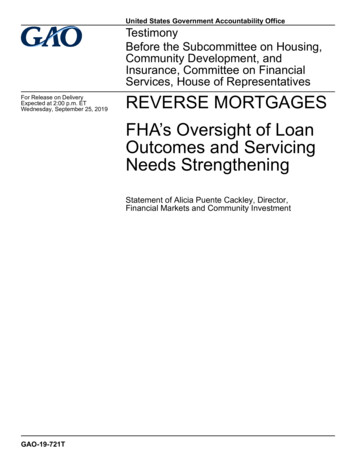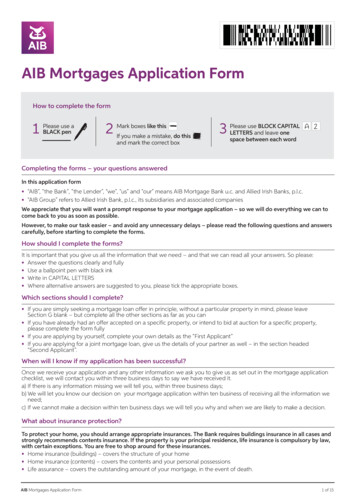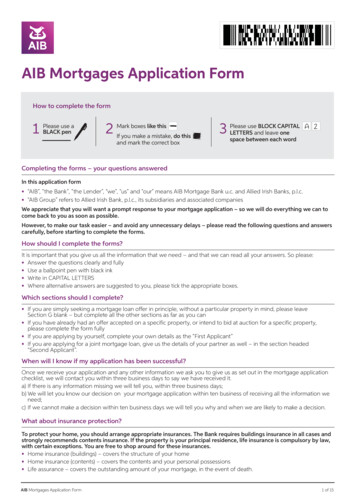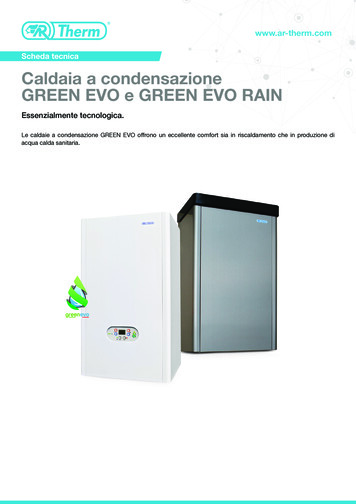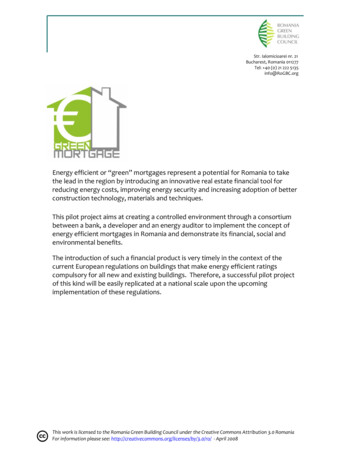
Transcription
Str. Ialomicioarei nr. 21Bucharest, Romania 011277Tel: 40 (0) 21 222 5135info@RoGBC.orgEnergy efficient or “green” mortgages represent a potential for Romania to takethe lead in the region by introducing an innovative real estate financial tool forreducing energy costs, improving energy security and increasing adoption of betterconstruction technology, materials and techniques.This pilot project aims at creating a controlled environment through a consortiumbetween a bank, a developer and an energy auditor to implement the concept ofenergy efficient mortgages in Romania and demonstrate its financial, social andenvironmental benefits.The introduction of such a financial product is very timely in the context of thecurrent European regulations on buildings that make energy efficient ratingscompulsory for all new and existing buildings. Therefore, a successful pilot projectof this kind will be easily replicated at a national scale upon the upcomingimplementation of these regulations.This work is licensed to the Romania Green Building Council under the Creative Commons Attribution 3.0 RomaniaFor information please see: http://creativecommons.org/licenses/by/3.0/ro/ - April 2008
RationaleFactso There is a close correlation between the energy efficiency performance of abuilding and the level of quality in the design, construction and operation ofa building.o Buildings account for over 30% of total energy consumption and 40 to 50% ofC02 emissions in Europeo The current buildings regulations impose only a low level of energyefficiency which leads to high energy costs for the end-users during theperiod of operation and ownershipo Romania has a housing deficit and faces a period of substantial residentialconstruction in the medium to long term.o Romania has implemented the “Energy Performance for Buildings Directive”requiring Energy Performance Certificates for new buildings as of January2007. The cost of the energy audit, therefore, no longer represents anoptional cost but a required cost of the real estate developer.o The current economic challenges notwithstanding, energy and naturalresource usage and price are expected to increase dramatically due toglobal economic and population trends.Implicationso Economic:o The energy bill will constantly increase affecting households’available income.o Energy costs and security are becoming a big concern for Romania’seconomic futureo Social: loss of energy subsidies will affect all households for all incomelevels. This does, however, effect the low and middle-income class of thepopulation as the energy bill is a higher percentage of their income and theygenerally live in lower quality (hence lower energy efficient) houses.o Environmental: at the planned rate of construction, the negative impact isincreasing significantly on the environment, the impact on the stock of fuelsand sustainable supply of natural resources.Need for action:Given all the above facts and implications, it results that energy efficientbuildings are a necessary and economically preferable solution.www.RoGBC.org
Financial Barrier:One of the most important barriers1 that prevents energy efficient buildingsfrom becoming mainstream is the issue of financing, especially related to theinitial cost barrier. Even if buyers are convinced of the long-term benefits of anenergy efficient home, the higher initial investment prevents them from buyingan energy efficient house. This in its turn reduces the developers’ incentives inconstructing an energy efficient building. The purpose of this pilot project is totackle and eliminate this financial barrier in a controlled environment.Energy Efficient or “Green” Mortgages:An energy efficient house reduces the utilities bill allowing households to saveextra cash that can be further applied to paying back a larger loan instalment.An energy efficient mortgage covers the extra financial investment that isneeded to make the energy efficient improvements upfront, recognising thatthe money will be recovered through the savings that occur over the lifetime ofthe building. This could imply larger loan amounts, increased debt-to-incomeratios (a larger amount of the borrower’s income can be applied to the monthlydebt instalments) or other financial incentives offered.Objective: Implementation of an innovative private sector-led financial product(energy efficient mortgages) based on the financial benefits of energy efficiency inbuildings, in order to facilitate the adoption of energy efficient and ecologicaltechnologies in residential building development.1Financing Energy Efficient ncialBarrierBuilding.pdf . Other barriers to energyefficient buildings are: information and awareness issues, standardised measures and control, thenature of the building market and perverse incentives of the players, principal agent problem, habitsand reluctance to change of both constructors and home buyers, lack of skills and knowledge.www.RoGBC.org
Brief description: The project proposes the creation of a consortium betweena real estate developer, a bank and a certified energy auditing company.o The developer would agree to create a residential development with highenergy efficiency standards (targeting an “A” grade).o A qualified energy auditor would assess/rate and control the energyefficiency of the development, quantify the energy savings as compared to aregular building, and issue the required energy efficiency rating certificate.o The bank would evaluate the monetary value of the energy savings and willimplement preferential:o Project finance: increased financing for the energy efficiency features(this function may be performed by an investor, not necessarily thebank)o Energy efficient mortgages for the buyers of the homeso The homebuyer receives a more valuable home and pays the same or lessfor their total monthly cost due to realized energy savings.www.RoGBC.org
Such a consortium creates a mechanism that allows for the energy efficiencysavings to be transferred from the developer to the home buyers without anyfinancial impact. The banks role is to allow the energy efficiency improvements topay for themselves and to reduce both the initial financial risk of both thedeveloper (who gains certainty of a market for the higher performing building) andthe home buyer (whose upfront investment is minimized).BenefitsGeneral benefits of the project:o Elimination of the initial cost barrier for implementing energy efficientresidential projectso Overcome other market failures that seriously inhibit the construction ofenergy efficient buildings including:o The “agency problem” - the different interests of the developer andbuyer are aligned though bank financingo The “information problem” - lack of understanding of the homebuyer of the reduction in the overall life-cycle costs due to energyefficiency measures is overcome by the energy audit and bankfinancingo The “rationality problem” - people do not always act rationally intheir economic interests when assessing short-term vs long-termbenefits. Introducing an Energy Efficiency component into financingbrings a new incentive that transforms long-term into short termbenefits.o Recognizes the higher value of an energy efficient building in terms ofincome security, quality, and market value.o Demonstrates a concept that can be replicated and scaled upward.The project will also bring important benefits to all the stakeholders:o For the developer, this scheme provides:o Secure financing for the cost increase due to energy efficiencymeasureso Transferring the increased cost to the home-buyer to the homebuyer who will ultimately benefit from the investmento Increased demand for a unique market offering and competitiveadvantage (as the home-buyer does not feel the burden of theincreased initial costs that are covered by the loan).o For the home-buyer the scheme provides:o Benefit from an energy efficient and better quality house with noadditional cost (or even net benefit from energy savings: Seefinancial calculations)www.RoGBC.org
o A higher price in case of reselling the house due to an “A” energyefficiency rating and the inherent quality improvements.o For the bank this scheme provides:o Introduction of a new financial product with predicable costs andrevenueso A possibility to tap into a niche market with very good prospectso An additional indication of a housing unit’s long-term value.o Differentiation in a highly competitive banking marketRisks and mitigating factorso Lack of demand for housing. This is a risk related to the general state of thereal estate market and not this energy efficiency scheme. In effect, anenergy efficient building should have a higher demand than regularbuildings in every real estate market.o Default of home buyers. The energy efficiency adds very little additionaldefault risk which is related only to the propensity of home buyers to spendthe energy savings rather than use them to pay back additional mortgagecosts. This risk to the bank could be mitigated by creating a governmentprogram that guarantees the additional amount of loan that is given forenergy efficiency houses. This reduces the perceived risk of the banks andprovides a low-cost incentive for energy efficient buildings (as compared toother types of subsidies).o Lower than expected performance of energy savings equipment andinstallations mean less energy savings. The requirements to achieve a topscore provide a strong degree of assurance the building will perform toexpectations. Components such as insulation and high efficiency Heating,Ventilating, and Air Conditioning (HVAC) equipment have been thoroughlyresearch with predictable results and, in the case of HVAC, backed bymanufacturers’ guarantees.o Overestimation of the energy efficiency savings by the certified auditors.This risk can be mitigated by carefully choosing the preferred energyauditors for the project. There is a defined methodology and apprenticeauditors are required to work with senior auditors for an initial period.o Falling energy prices. Despite current economic challenges, energy pricesand energy scarcity are predicted to go substantially higher. An increasingwillingness of the EU and Romanian government to “price carbon” and taxinefficient behaviour reduces the likelihood that the energy price to the endconsumer will decrease. Dramatic and widespread technological advancesin “green” energy might reduce long term prices but the positive economicbenefits of this optimistic scenario should clearly outweigh the smallerdifferential in financial savings due to energy efficiency measures.www.RoGBC.org
Future prospectsThe European Commission has upgraded the Energy Performance for BuildingsDirective to make it more demanding of higher energy performance (i.e. an “A” isharder to achieve) and requiring “nearly zero energy” buildings in the next decade .This indicates a political and economic climate more supportive of energy efficiencyin buildings. It is the position of the Romania Green Building Council to stronglysupport a more stringent implementation of this directive.As the energy prices continue to go up and the price of energy efficienttechnologies reduces, the economic reasoning for energy efficient mortgagesbecomes even more powerful. Ultimately, energy efficient buildings will becomemainstream and all mortgages will be energy efficient mortgages.Efforts to install individual metering since 1995 have and will continue tosignificantly encourage rational economic behaviour and guarantee uptake ofenergy efficiency and green mortgage products.Financial Case for Green MortgagesAs stated previously, energy efficient mortgages cover the extra financialinvestment that is needed to make the energy efficient improvements upfront,recognising that the money will be recovered through the savings that occur overthe lifetime of the building. The calculations below demonstrate the financialfeasibility of such a bank product.The green mortgage is applied to 75 sqm apartment and takes into account thecurrent market rates and conditions of the Romanian real estate, construction,energy and mortgage market. The data is based both on secondary research and ondiscussions with various specialists in the construction and energy efficiency fields.www.RoGBC.org
a real estate developer, a bank and a certified energy auditing company. o The developer would agree to create a residential development with high energy efficiency standards (targeting an "A" grade). o A qualified energy auditor would assess/rate and control the energy efficiency of the development, quantify the energy savings as compared to a


